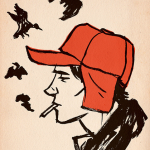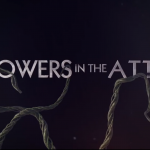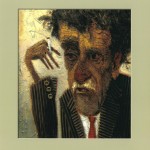It seems like writer Cormac McCarthy is everywhere in pop culture these days. The Coen brothers’ No Country for Old Men (based on McCarthy’s novel of the same name) won top prizes at this year’s Oscars. His most recent novel, The Road, won the 2007 Pultizer for fiction–and perhaps even more significantly for its popularity, it was an Oprah’s Book Club selection. Entertainment Weekly just named The Road the most significant novel of the past 25 years, and it will be released as a film (starring Viggo “Aragorn” Mortensen) in November 2008.
So far, no one has yet made a movie of McCarthy’s 1985 novel Blood Meridian, viewed by many as his best work (though there are rumors of a Ridley Scott-helmed adaptation in the future). You thought No Country for Old Men was violent? Blood Meridian wins the contest hands-down. Scalpings, rapes, heads bashed in, disembowelings, you name it. Set on the border of Texas and Mexico in the late 1840s (just after the Mexican-American war), the novel follows “the kid,” a sixteen-year-old who takes up with a band of mercenaries (the Glanton Gang) who have contracted with the Mexican government to kill Apache Indians. His main adversary, however, turns out not to be the Apaches, but “the judge,” an unspeakably cruel and manipulative member of the Glanton Gang.
Though Christians have spent a lot of time discussing sex and language in movies and books, we’ve generally devoted less effort to analyzing the effect of reading about or viewing violence. Here, two of our CAPC writers, Alan Noble and Carissa Smith, discuss these issues in relation to Blood Meridian.
In the first installment of their dialogue, they describe their initial experiences with the novel and discuss what Christian and non-Christian readers could possibly gain from reading it.
Carissa: “Yep. We’re depraved. Tell me something I don’t already know.”
I picked up Blood Meridian at a used book sale a few weeks ago, figuring that, since I liked Cormac McCarthy’s most recent novel, The Road, I should give some of his other works a try. I chose Blood Meridian above the other McCarthy possibilities at the sale because a friend had told me it was “life-changing,” though gruesome. I read it on planes and in airports during a recent trip to Texas, thinking that if I didn’t like it, at least it would give me a little local atmosphere.
It was helpful to be reading the novel in a place where I could visit the Texas State History Musuem, given that McCarthy doesn’t fill in much of the historical background surrounding his party of mercenary scalpers. It was helpful for reminding myself just when exactly the Republic of Texas existed. And it was pretty cool to read about the judge making saltpeter from bat guano and then, the next day at a park, to see a large kettle in which, the sign proclaimed, settlers used to make saltpeter from bat guano.
Unfortunately, the fact that saltpeter can be made from bat guano is about all that I feel I ultimately got from Blood Meridian. Let me say right off that I can appreciate a book portraying lots of violence if the violence contributes to the storytelling. Violence is somewhat essential to Flannery O’Connor’s storytelling style, for example, as there it represents the force of God’s grace. Sometimes violence in a story serves to deepen our understanding of human nature and original sin–and I tried to find some way in which Blood Meridian did this for me, but kept drawing blanks. I found myself thinking, “Yep, humanity is depraved. I already know this. Quit with the endless examples and tell me something I don’t know.” On the other hand, I worry that, because the violence is so extreme, a non-Christian reading the book will not be convicted of his or her own sinfulness–or even general human sinfulness–because the judge’s cruelty is so over-the-top that it’s all too easy to paint him as inhuman. Plus, given the book’s historical setting, readers might think, “Wow, people were so wrong back then–I’m glad we’re more enlightened now”–rather than pondering the ways that such atrocities continue, even within the individual’s heart.
So my question about Blood Meridian is twofold: (1) What can a Christian gain from reading the novel? and (2) What in the novel could help a non-Christian move closer to Christ? I don’t doubt that people can find value in the novel, nor do I wish to condemn anyone for doing so; but I’m curious to see if there’s a reason I should keep my copy of the novel, rather than selling it back to my local used bookstore.
Alan: “Blood Meridian demonstrates the desire for order in an unjust world.”
I’m going to try to keep this brief, but since I wrote a few hundred pages on this book over the course of a thesis, a conference paper, and a few seminar papers, I might fail. In fact, I think I already failed.
My first encounter with Blood Meridian was actually in an English 102 class at a Community College. At that time I wasn’t as interested in really engaging the text so much as passing the class, so I spent much of my time trying to sort through McCarthy’s challenging dialogue, particularly in the last few pages of the novel. It wasn’t really until I reread the novel for a graduate seminar that I fell in love with it and became lost in its labyrinth-like language and themes. What drove my new love for the book was the central idea of silence.
I’m going to answer your question by dealing with two aspects of the novel that both deal with the violence and the issue of what can be gained – what sort of redemptive (or redeeming) themes/issues are presented.
Near the middle of the novel, an ex-priest named Tobin speaks to the main character, the kid, concerning the voice of God in the world. The kid says, “I aint heard no voice,” to which Tobin replies, “When it stops, you’ll know you’ve heard it all your life.” This idea of how the silence of God can make a person aware of His existence is, I believe, one of the central themes of the novel. The world of Blood Meridian appears godless. Violence is ubiquitous, nearly every character is horribly evil, and there is no hero who rights these wrongs to our liking. Perhaps the most disturbing aspect of the many violent scenes is the morally neutral stance the narrator and characters seem to take. People die, are raped, are mutilated, tortured, treated as animals, and yet the descriptive language is detached and even a bit lovely in its colorfulness*. It is this very absence of judgement and morality that most compellingly alludes to the presence of God in this world.
McCarthy gives us the classic good/evil binary but fails to present the other half of the binary, leaving us with evil. For most readers, and at least the kid, this binary must be completed. The horrifying absence of goodness and justice in the world creates in both the reader and the kid a desire for justice**. We need to see this world drawn out of chaos. Mexico in the novel is described as godless, and as the kid encounters this godlessness he moves from feeling that existence is validated through violence (the domination of one will over another or others), the stance of the judge, to a inchoate belief in a “love thy neighbor” ethos. Which brings me to the second aspect, the maturation of the kid and his opposition to the judge.{/column2}
As I stated, when Blood Meridian first begins, we are presented with a kid who is devoted to the shedding of blood. He literally believes that through violence mankind (and existence) is validated. This ideology (the self versus the world) is embodied in the judge who takes it to an extreme. The judge is preoccupied with forcing the world to submit to his will. He sketches artifacts in a notebook and then destroys them so that only he controls them. He calls the birds an affront to him. He kills and rapes. He controls the Glanton Gang through manipulation and lies. And he teaches them that the greatest action a person can take is to pit his life against that of another. Because in this act one person’s existence is posed against another’s. The judge’s approach to nature, science, and philosophy suggest that he is a horrifying caricature of an Enlightenment rationalist. In addition, the philosophy he presents to the Glanton Gang has some striking similarities to Nietzsche’s existentialism, albeit a much more violent version. We can sum the judge’s philosophy up by stating that he seems to have come to the conclusion that God is dead and that the greatest validation of a person is the will to power.
And while the kid seems to agree with this ideology in the beginning of the book, through his experiences with the gang he begins to turn from this belief system, much to the disgust of the judge. At several critical moments in the text we find the kid choosing to put others before himself, to be a “good Samaritan” even at the risk of his own life. The kid begins to adopt a “love thy neighbor” morality which is in direct opposition to the judge’s “will to power” philosophy. By the end of the novel the judge is intent on killing the kid, and the kid has several chances to kill the judge, but he refuses to, which is his downfall.
In the judge’s worldview, existence is all that matters and violence can control existence. For the judge, to kill is to be right. But for the kid, existence is not what is supremely important. By the novel’s end, the kid seems to be aware that God exists and he actively searches for Him, although he is ultimately unable to come to any real Faith. After he leaves the judge he kills only once in self-defense, and begins carrying a Bible. He has come to realize that the (essentially) existentialist system that he had previously held to was incomplete. This leads him to pass up the opportunity to kill the judge, because to kill the judge would be to concede to the judge’s worldview; the will to power. So while the kid doesn’t physically stop the judge, he is the only person in the judge’s grasp that manages to reject an atheistic, will to power philosophy.
Now let me see if I can answer your question on a more practical level.
For the Christian I think one thing that can be gained is the idea that often the best response to a debate is silence. Much like Alyosha in The Brothers Karamazov, the kid does not answer the judge’s philosophical arguments with words but with actions. God’s existence is not shown through an eloquent intellectual challenge to the judge, but with the kid’s refusal to concede to the judge’s worldview. I think it also presents a world which is continuously alluding to God’s existence, but in incredibly quiet ways, sometimes silent ways. The chaos of the world calls for order, for a Righteous God. The sublime descriptions of the landscape suggest a world filled with purpose and meaning even though it is populated with depraved individuals.
For the non-Christian, I think the horrifying chaos in the novel can present a profound desire for order, for justice, for a Righteous God. And the judge’s existentialist worldview is a frightening challenging. The judge is eloquent, and the brutal worldview he presents seems to logically flow out of his atheism, or at least out of his materialist, Enlightenment ideals. To identify one of the most horrifying characters in American literature with some of the most privileged ideals of American history (enlightenment rationalism, scientific materialism, atheistic existentialism, moral relativism) is a bold and possibly challenging decision.
Ultimately, Blood Meridian is not a book I would recommend to many Christians, or most Christians for that matter. It is disturbing in its visuals and challenging in its ideas, but the way McCarthy skillfully presents opposing worldviews and explores their conclusions makes it my favorite novel.
*McCarthy, anticipating the reaction that the violence of the novel is just an example of how civilized modern man is, includes in the preface an account of a 300,000 year old skull that had been scalped. For McCarthy, the violence in the novel transcends its location in geography and time.
**Thomas Hibbs, a professor at Baylor, recently proposed this very concept in relation to film noir, arguing that the moral ambiguity and even chaos in film noir results in a profound need for order in both the viewer and the main characters. The Art of Darkness











